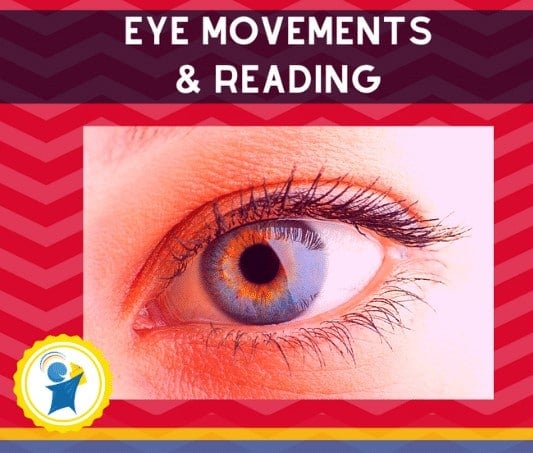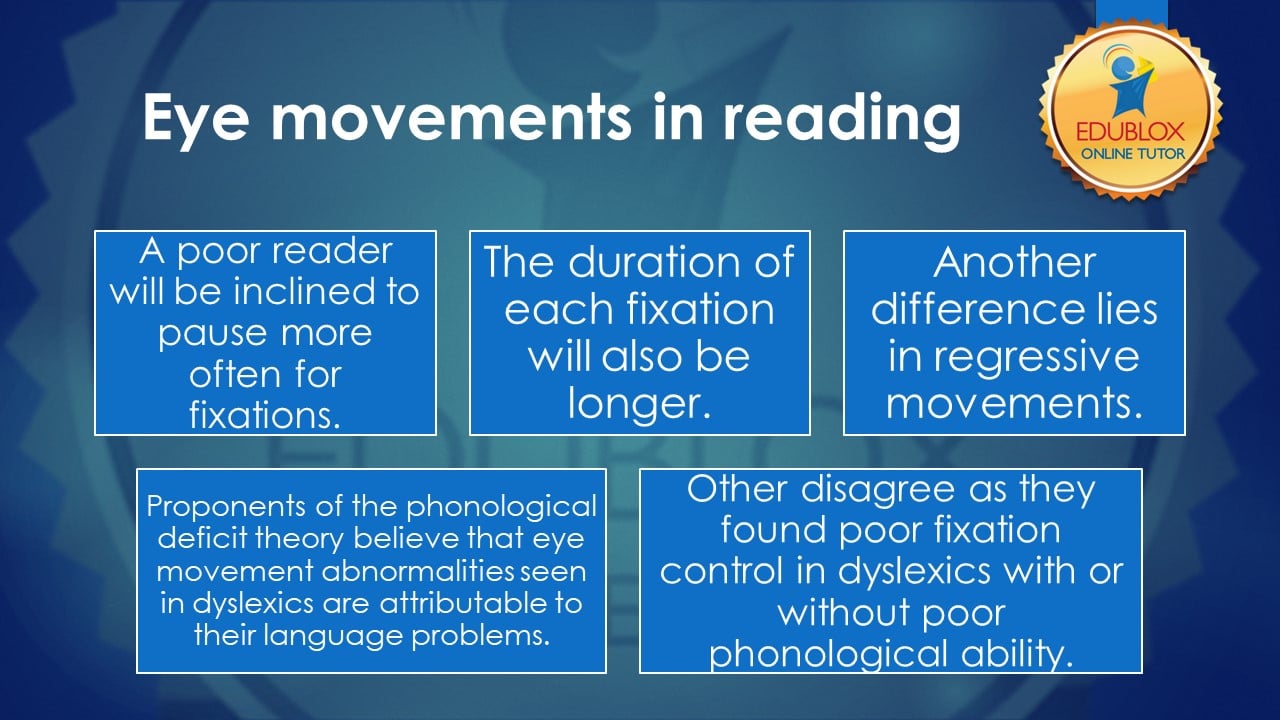Table of contents:
- How our eyes move when we read
- Eye movements of poor readers
- A consequence of poor reading, not a cause
- Poor eye movements a cause of dyslexia
How our eyes move when we read

If we think about what our eyes are doing as we read, we imagine them moving in a smooth line from left to right, line by line. However, this is not the case.
Our eyes move across a line of print in a series of quick movements broken by very brief pauses. The movements are called “saccades.” They are so fast that we are not aware of them. Our brain blanks out whatever signals come from our eyes during these saccadic movements. We are only aware of what we see during the pauses.
We are also unaware of the pauses, so it is easy to believe our eyes move smoothly across the page. However, when watching another person read, we can see the quick, jerky movements.
What we probably cannot do, because they are so quick, is to count the movements. The pauses, called “fixations,” last only one-quarter to one-fifth of a second.
The typical beginner reader makes an average of two fixations per word or, in other words, sees or recognizes less than one whole word at each fixation. This statistic was determined by photographing the reading of over a thousand first-graders with The Reading Eye, a camera made especially for this purpose.
Each child read a selection of approximately 100 words. During reading, the average child made 224 fixations, about two fixations per word or an eye span of .45 of a word. This average span of recognition increases very slowly to 1.11, or slightly more than one word per fixation, for typical college students at an average speed of 280 words per minute. The average number of words seen at each fixation reaches one whole word in the eleventh grade.
Eye movements of poor readers
A person with dyslexia or a poor reader will be inclined to pause more often for fixations, and the duration of each fixation will also be longer than that of the typical reader.
Another difference between good and poor readers lies in regressive movements. All of us move our eyes backward from time to time in reading. Poor readers do it more often than good readers, but there is a further difference: good readers know where to regress to. They go back to the beginnings of phrases and sentences, and they can pick out important and difficult passages to reread (because that is what regressive movements amount to). Poor readers move their eyes back regardless.
One more difference between skilled and unskilled readers is in the return movement. Return movements occur when we move our eyes from one line of print to the next. Good readers make a single, clean movement from the end of one line of print to the beginning of the next. Poor readers overshoot or undershoot, so they have to make corrections to find the beginning of the line.
A consequence of poor reading, not a cause
In the first half of the 20th century, the visual processing deficit theory was the most popular explanation for dyslexia and poor reading. Visual processing refers to the brain’s ability to make sense of what the eyes see. Studies focused on eye movements, visual sensing, visual processing, and visual memory.
However, based on the work of Chomsky, Vellutino, Stanovich, and Adams, the visual processing deficit theory was replaced by the phonological deficit theory (Stein, 2018). This theory states that individuals with dyslexia are unaware of the phonological or sound structure of language.
Proponents of the phonological deficit theory claim that eye movement abnormalities in people with dyslexia are attributable to their language problems. According to Stanovich (1986), the relationship of certain eye movement patterns to reading fluency has repeatedly – and erroneously – been interpreted as indicating that the efficiency of the eye movements themselves determine reading ability.
“The assumption that these particular eye movement characteristics were a cause of reading disability led to the now thoroughly discredited ‘eye movement training’ programs that repeatedly have been advanced as ‘cures’ for reading disabilities,” Stanovich states. He continues:
We now recognize that eye movement patterns represent a perfect example of a causal connection running in the opposite direction. Poor readers do show the inefficient characteristics listed above, but they are also comprehending text more poorly. In fact, we now know that eye movements rather closely reflect the efficiency of ongoing reading—with the number of regressions and fixations per line increasing as the material becomes more difficult, and decreasing as reading efficiency increases—and this is true for all readers, regardless of their skill level. When skilled readers are forced to read material too difficult for them, their eye movement patterns deteriorate and approximate those usually shown by the less skilled reader. The eye movement patterns of the latter look more fluent when they are allowed to read easier material. In short, the level of reading determines the nature of the eye movement patterns, not the reverse.
Poor eye movements a cause of dyslexia
Many have come to realize that dyslexia is a far more diversified problem than generally believed, and the problems of dyslexics reach beyond the limits of traditionally defined language deficits stemming from damaged phoneme awareness.
Eden et al. (1994) studied eye movements in dyslexic children during several non-reading tasks. Dyslexic children (n = 26) had significantly worse eye movement stability during fixation of small targets than typical children (n = 39).
The authors conclude that oculomotor abnormalities in a non-reading task strongly suggest that the underlying deficit in the control of eye movements seen in people with dyslexia is not caused by language problems alone. The results were also compared to the children’s phonological ability. Poor fixation control was found in dyslexics with or without poor phonological ability.
This study and others stress that at least one subtype of dyslexia is affected by differences in visual processing, which can be detected within eye movement recordings (Franzen, 2021).
Bellocchi (2013) concludes: “Reading is a highly complex task involving the rapid coordination of visual, phonological, semantic and linguistic processes in order to access meaning.”
Edublox offers cognitive training and live online tutoring to students with dyslexia, dysgraphia, dyscalculia, and other learning disabilities. Our students are in the United States, Canada, Australia, and elsewhere. Book a free consultation to discuss your child’s learning needs.
Eye movements in reading – key takeways

Authored by Susan du Plessis (B.A. Hons Psychology; B.D.), an educational specialist with 30+ years’ experience in the field of learning disabilities.
.
References and sources:
Bellocchi, S. (2013). Developmental dyslexia, visual crowding and eye movements. In L. C. Stewart (Ed.). Eye movement: Developmental perspectives, dysfunctions and disorders in humans (pp. 93-110). New York, NY: Nova Science Publishers.
De Luca, M., Di Pace, E., Judica, A., Spinelli, D., & Zoccolotti, P. (1999). Eye movement patterns in linguistic and non-linguistic tasks in developmental surface dyslexia. Neuropsychologia 37, 1407–1420.
Eden, G. F., Stein, J. F., Wood, H. M., & Wood, F. B. (1994). Differences in eye movements and reading problems in dyslexic and normal children. Vision Research, 34(10), 1345–1358.
Franzen, L., Stark, Z., & Johnson, A. P. (2021). Individuals with dyslexia use a different visual sampling strategy to read text. Scientific Reports 11, 6449.
Hutzler, F. & Wimmer, H. (2004). Eye movements of dyslexic children when reading in a regular orthography. Brain Lang. 89, 235–242.
Olson, R., Kliegl, R., & Davidson, B. (1983). Dyslexic and normal readers’ eye movements. Journal of Experimental Psychology: Human Perception and Performance, 9, 816–825.
Rayner, K. (1985). Do faulty eye movements cause dyslexia? Developmental Neuropsychology, 1, 3–15.
Rayner, K. (1985). The role of eye movements in learning to read and reading disability. Remedial and Special Education, 6, 53–60.
Rayner, K. (1997). Understanding eye movements in reading. Scientific Studies of Reading, 1(4), 317–339.
Razuk, M., Barela, J. A., Peyre, H., Gerard, C. L., & Bucci, M. P. (2018). Eye movements and postural control in dyslexic children performing different visual tasks. PLoS ONE 13, e0198001.
Stanley, G., Smith, G., & Howell, E. (1983). Eye-movements and sequential tracking in dyslexic and control children. British Journal of Psychology, 74, 18 1–187.
Stanovich, K. E. (1986). Matthew effects in reading: Some consequences of individual differences in the acquisition of literacy. Reading Research Quarterly 21(4), 360-407.
Stein, J. (2018). The magnocellular theory of developmental dyslexia. In T. Lachmann, & T. Weis (Eds.). Reading and dyslexia (pp. 97-128). Cham, Switzerland: Springer.
